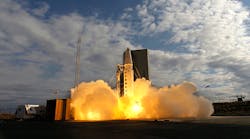In a test performed by the U.S. Missile Defense Agency and a Boeing-led industry team, the ground-based midcourse defense (GMD) system intercepted and destroyed a target using an enhanced version of an exoatmospheric kill vehicle (EKV) device. The GMD system is a missile defense program that helps defend against long-range ballistic missile attacks.
Receiving updates from the GMD system, the EKV detected and tracked the target, and then destroyed it through a high-speed impact. The test met various key objectives, including a long flight time and high-velocity closing speeds.
In development since 1998, the GMD system incorporates features such as early detection and tracking during the boost phase, midcourse target discrimination, and precision intercept and destruction of inbound intercontinental ballistic missiles (ICBMS). The program is a major facet of the U.S.’s multilayered ballistic missile defense architecture. The entire program consists of command-and-control facilities, communications terminals, and a 20,000-mile fiber-optic communications network.
In addition to Boeing, industry team participants included Bechtel, Northrop Grumman, Orbital Sciences Corp., Raytheon, and Teledyne Brown Engineering.

